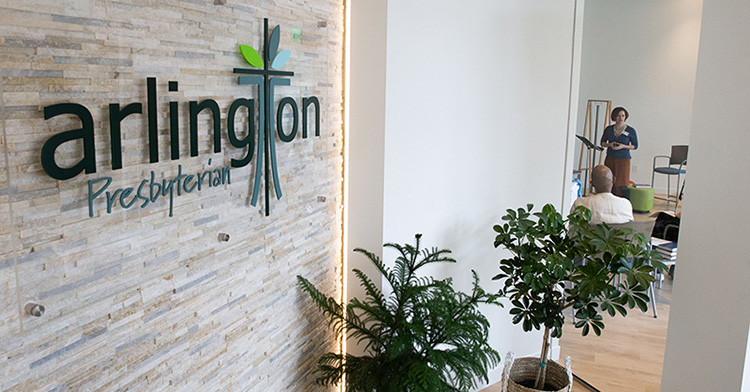No one was laughing when Our Lady of Mount Carmel Catholic School closed in 2012. Not only were the residents of the South Philadelphia neighborhood losing what had been a bulwark institution for generations; they also had no idea what would become of the landmark building.
So when 1812 Productions, Philadelphia’s only all-comedy theater company, arrived about a year later to inhabit the space with its antics, the parish applauded. And they welcomed the company at an ice cream social.
“To have a school close in a community is such a big deal,” said Jennifer Childs, co-founder and artistic director of 1812 Productions. “To know there are still important things happening in that space means a lot to them. They are thrilled that something creative is still going on here.”
What "important things" would neighbors say are happening in your church?
It was a match made in heaven, with more than a little help from Making Homes for the Arts in Sacred Places (AiSP), an initiative that fosters partnerships between arts groups that need space and congregations that have plenty to spare. The program is an offshoot of Partners for Sacred Places, a Philadelphia-based nonprofit established in 1989 to advocate for the sound stewardship and active community use of America’s older religious properties.
The theater company rents the repurposed Our Lady of Mount Carmel classroom space for $3,000 a month. For that, they get twice the amount of room for $10,000 a year less than they had been paying. Now, in the same building where hallway coat hooks hark back to school days, and where a downstairs chapel still holds the parish weekday Mass, Childs and her troupe make funny in expanded rehearsal and office space. She and the landlord-pastor have lunch periodically, comparing notes on each other’s calling.

Photo by Sabina Pierce
“Having a landlord who understands mission-driven work is astonishing,” Childs said.
The arts need their space. For the roughly 2,000 arts organizations in Philadelphia, whether fledgling or established, space is typically one of the greatest expenses and most critical needs, second only to personnel. At the same time, some two-thirds of Center City Philadelphia sacred places report having space that could potentially be available for sharing with the community.
What resources are being underutilized in your church? Who could put them to better use?
Enter the director
Enter Karen DiLossi, the director of Arts in Sacred Places. With a background in theater, DiLossi first saw the potential for bringing congregations and arts groups together during her eight-and-a-half-year tenure at the former Theatre Alliance of Greater Philadelphia, a service organization for the city’s arts community. Together with Partners for Sacred Places, the Theatre Alliance had begun to research and occasionally advise churches and arts groups to share space. When DiLossi came on board at Partners in 2011, Arts in Sacred Places was born, formalizing the program.

Photo by Sabina Pierce
AiSP now tracks congregations with unused space and arts companies that need it, pairing up underused fellowship halls, Sunday schools, sanctuaries and other church buildings with theater, dance, music and other arts groups. The organization helps partners draw up leases, figure out how much to charge, and negotiate terms. And it facilitates enduring relationships by providing training on how to be a successful landlord, and a good tenant.
In its three and a half years, the nonprofit organization, entirely grant-funded, has brokered 16 long-term space-sharing arrangements and numerous short-term partnerships. Its standing in the Philadelphia community makes AiSP the go-to when groups need or have space. And elsewhere, its reputation is growing.
Could your church broker needs and resources in your community?
“They’re a very creative, very valuable organization,” said Amy Fitterer, the executive director of Dance/USA, a Washington, D.C.-based advocacy group for professional dance. “They’re doing really important work by keeping these sacred venues in the community -- taking space that should remain in use and using it for the public good.”
Done well, the matches are a classic win-win. Congregations gain much-needed income to maintain expensive-to-carry, unused rooms and buildings. Artists gain below-market-rate space in generally mortgage-free buildings. Neighbors get a surge in street activity on formerly quiet, even desolate, blocks.
Ideal space for the arts
Though designed for a very different purpose, houses of worship offer ideal space for arts groups. Fellowship halls have large open expanses, often unimpeded by pillars. Their floors, compared with those of commercial spaces, are often softer -- essential for dancers’ safety. And sanctuaries, with their theaterlike pews, light-flooded altar areas, lovely acoustics and striking architecture, are natural performance rooms.

Photo by Sabina Pierce
Artists are inspired by the spaces, said DiLossi -- “the oldness, the sacredness.” At the same time, the church community provides the performers a stable counterweight to what can be a nomadic existence.
Expanding beyond Philadelphia, AiSP is also doing some matchmaking in Chicago and providing informal counsel elsewhere. Baltimore, Detroit and Austin are currently under study via a grant-funded program to determine need and availability, and to compile a database of potential matches.
Rents and deals vary with each partnership, but AiSP aims for consistency, using a formula that factors in square footage, the term of the lease, frequency of use and whether the use is shared or exclusive. DiLossi figures on an hourly rate of about $10 to $20 for short-term rehearsal space, but the ideal, she explained, is the long-term, exclusive match. This may yield the host site $15,000 to as much as $50,000 annually, minus the costs of renting the space. Some facilities have a staff member on hand when the tenants are there, while many simply entrust their renters with the keys.
In Philadelphia, AiSP has been known to perform miracles. Director Alysia Lee’s Sister Cities Girlchoir, for instance, had only a month’s notice earlier this year that its Saturday rehearsal space was closing. Without missing even a single rehearsal, the group was installed at First Presbyterian Church in Philadelphia’s Kensington neighborhood, right where they wanted to be.
The pastor and some of the elders welcomed them, happy at the chance to serve as a safety net. The choir got room to expand, as well as occasional use of the sanctuary for performances. Lee envisions a growing bond between the congregation and her girls -- at-risk students for whom the choir provides life skills as much as music. Out of the emergency, “great good prevailed,” DiLossi said.
Intangible benefits
The partnerships are about more than rental income or square footage. Some of the most important benefits are intangible. As the congregants enjoy the artists’ infusion of youth and energy and appreciation for their buildings, the artists grow to value being part of a stable community, within and beyond the congregation.
As more people -- both artists and audience members -- experience the spaces, public support grows for saving and preserving the beautiful old church buildings. People begin seeing buildings they once walked by with barely a glance as community assets.

Photo by Sabina Pierce
DiLossi recalled one Philadelphia church that shared its lobby with a theater company. On performance nights, curious theatergoers regularly peered into the locked and darkened sanctuary. Eventually, the church began leaving the sanctuary lights on during play runs so as to share their church’s beauty with visitors.
Theatre people tend to soak up the sacred spaces, DiLossi said. “They’re artists. They want to know everything: What’s the story? What’s the history?”
The Rev. Fred Kinsey, the pastor of Unity Lutheran Church in Chicago, sees an average Sunday attendance of 40, in a changing neighborhood that houses two other Lutheran churches of the same synod. Income from AiSP partnerships has boosted morale at his struggling church.
“The biggest benefit is our status in the community,” Kinsey said. “Everybody sees that we are a congregation that’s active. Now, when it comes to the alderman’s office, to the chamber of commerce, we are a minor player.”
Where does the community see signs of life in your church?
Kinsey said it took some doing to convince his struggling congregation that opening their arms and their space to outsiders was a good idea. But church rooms they considered sacred cows -- long designated as the space for Boy Scouts or other activities -- hadn’t been more than storage closets in years.
As with other church leaders, Kinsey considers the partnerships as much outreach as book balancing, and he’s worked hard to convey that to his congregation.
“I explained that this is a way we can reach out to the community,” he said. “It’s who we are as Christian people.”
The worst of the adjustment period seems to be over, he said, though the struggle to make ends meet remains: “AiSP gave us a little bit of extra hope that we can make something happen here.”
Shiloh Baptist Church, one of the original AiSP partners, shares space that hadn’t been used in 15 years with two performing groups at its vast Philadelphia complex. With his congregation wary at first, the Rev. Edward Sparkman said he pointed them to their prayers: “We’ve asked the Lord for help, and now he’s helping us.”
Today, church members take things in stride, even attending their dance company’s performances and inviting performers to church activities.
“Now, a lot of our members are viewing the church as being alive,” Sparkman said.
Content and other issues
Of course, all is not perfect -- not only because longtime church members can be change-averse. A house of worship needs to have ample space available to accommodate the diverse needs that may arise. Noisy rehearsals may conflict with church events and need to be rescheduled. Lights may get left on. Congregation leaders may deliberate too slowly for impatient potential tenants.
And then there’s the matter of content. Will the incoming troupers infuse sacred buildings with vulgarity, even nudity? Will the partners’ politics conflict? Will the landlord pressure an edgy director to edit when the director wants to go full-throttle? These are the situations that can make or break a partnership, and guiding the parties through long and serious talks is AiSP’s specialty.
“Relationships are so key,” DiLossi said. “Discussions are so key.”
Taking into account the particular nature of each congregation and arts group, the partnerships manage to come up with arrangements that work for both sides. Some congregations and theater groups reach a kind of “don’t ask, don’t tell” policy regarding creative content. Others agree that a sanctuary should be for holy use alone, while the rest of the building is less sensitive. And others agree that all church space may be used by a group, like the Girlchoir, whose art is by nature uplifting.
To DiLossi, art is much like church. Raised Catholic, the 38-year-old fell in love with drama as a freshman at Washington College in Maryland. She’d been planning on law school, but the draw of the stage, with its sense of purpose and community, made her realize she had a different vocation -- a “calling,” in the parlance of her Catholic schooling.
Is DeLossi right about the similarities between art and church? How so?
Before long, she said, theater “became my church.”
While some churches want to keep their partners’ art wholesome, others believe that showing the underbelly of life can itself be a ministry, DiLossi said. Such is the case with the Church of the Crucifixion, an Episcopal congregation in downtown Philadelphia that rents its former parish house to Luna Theater Company, a group unafraid of pushing the limits. Luna bills this year’s offerings as “Season of Seduction.”
DiLossi believes that church can be an appropriate venue for theater that brings troubling issues into the light. After all, it’s not just the Ladies Auxiliary and the Men’s Group that meet in church basements. So too do groups like Alcoholics Anonymous and Narcotics Anonymous -- where real-life drama incorporates all manner of struggle.
Light and dark, comedy and drama
In the theater and in the church, there is room for both light and dark, comedy and drama. And if Luna Theater is at one end of the spectrum, 1812 Productions is at the other. Seated around a script-strewn table in their vintage classroom one recent frigid morning, a half-dozen members of the comedy group make like the schoolchildren whose space they now inhabit.

Photo by Sabina Pierce
They laugh. They try out this pitch and that inflection. They tinker incessantly to extract the best of the funny from their latest work, “ To the Moon,” a comedy inspired by the life and work of Jackie Gleason. Again and again they repeat their soft-shoe number, honing the arm angle here and the footwork there, whittling it till it’s sharper, better, funnier, more nearly perfect. When it opens April 16, “To the Moon” will be everything they can possibly make it. Their work, after all, gives people a break from real life’s darker dramas.
Her company and her landlord have a lot in common, director Jen Childs observed. “We’re both trying to do good in the world.”
Questions to consider
Questions to Consider
- What “important things” are happening in your church or organization? What would neighbors say, if asked that same question?
- What assets -- space, people, talents or other resources -- are underutilized by your church or organization? How could they be put to better use? Who might benefit from them?
- How do the church-arts partnerships in Philadelphia change your understanding of church? Of the relationship between church and the community?
- What organization or other entity can broker needs and resources in your community? Could your church do that?
- What are your church’s vital signs? In what ways is it most alive to the surrounding community? How is it helping the community thrive?
- How, if at all, are the arts like church? How are they different? What human needs do the arts meet? What do the arts provide that the church can’t?
- How can the church speak more truthfully about both light and dark?













